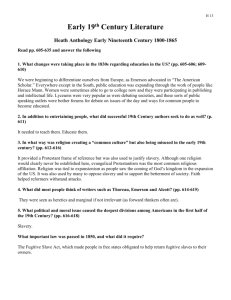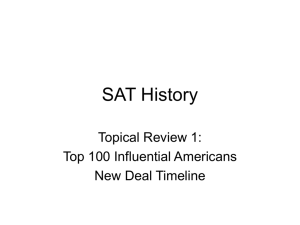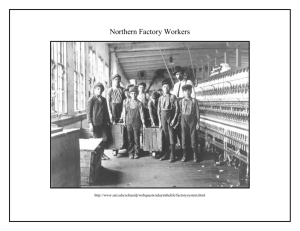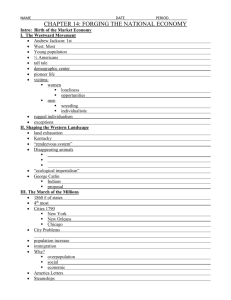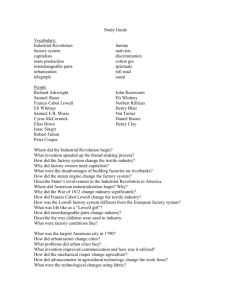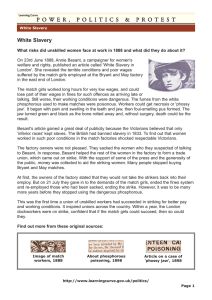AP U.S. History “Unit Five Study Guide – Chapters 14, 15, and 16
advertisement
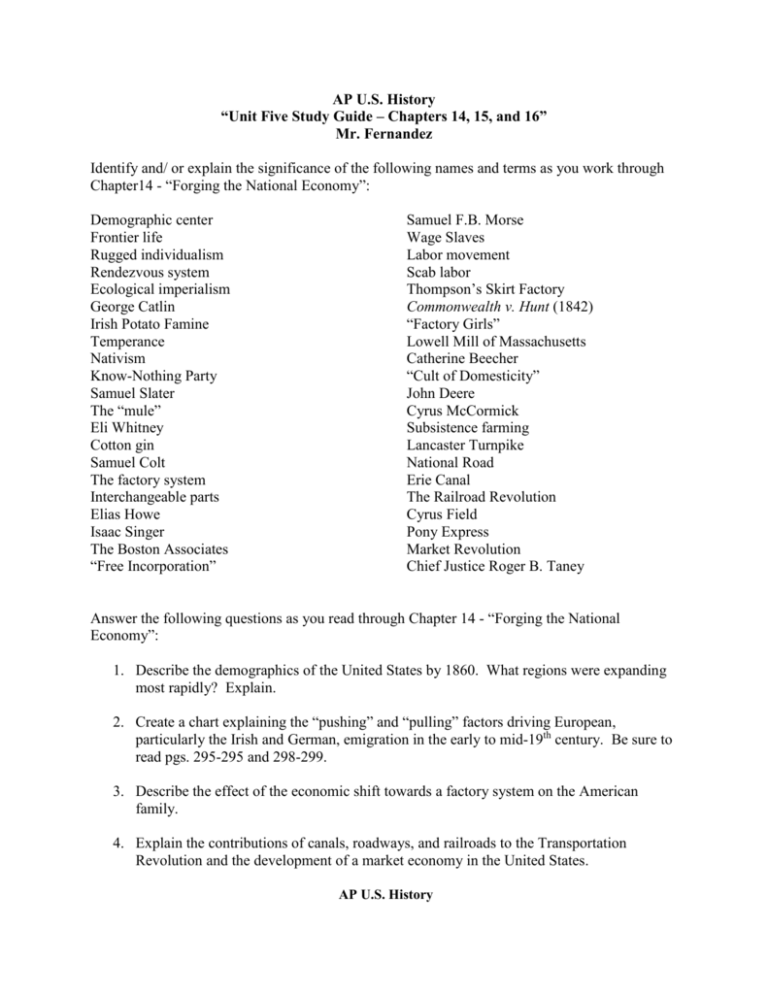
AP U.S. History “Unit Five Study Guide – Chapters 14, 15, and 16” Mr. Fernandez Identify and/ or explain the significance of the following names and terms as you work through Chapter14 - “Forging the National Economy”: Demographic center Frontier life Rugged individualism Rendezvous system Ecological imperialism George Catlin Irish Potato Famine Temperance Nativism Know-Nothing Party Samuel Slater The “mule” Eli Whitney Cotton gin Samuel Colt The factory system Interchangeable parts Elias Howe Isaac Singer The Boston Associates “Free Incorporation” Samuel F.B. Morse Wage Slaves Labor movement Scab labor Thompson’s Skirt Factory Commonwealth v. Hunt (1842) “Factory Girls” Lowell Mill of Massachusetts Catherine Beecher “Cult of Domesticity” John Deere Cyrus McCormick Subsistence farming Lancaster Turnpike National Road Erie Canal The Railroad Revolution Cyrus Field Pony Express Market Revolution Chief Justice Roger B. Taney Answer the following questions as you read through Chapter 14 - “Forging the National Economy”: 1. Describe the demographics of the United States by 1860. What regions were expanding most rapidly? Explain. 2. Create a chart explaining the “pushing” and “pulling” factors driving European, particularly the Irish and German, emigration in the early to mid-19th century. Be sure to read pgs. 295-295 and 298-299. 3. Describe the effect of the economic shift towards a factory system on the American family. 4. Explain the contributions of canals, roadways, and railroads to the Transportation Revolution and the development of a market economy in the United States. AP U.S. History “Unit Five Study Guide – Chapters 14, 15, and 16” Mr. Fernandez Identify and/ or explain the significance of each of the following names and terms from Chapter 15 “The Ferment of Reform and Culture”: Utopia The Second Great Awakening Thomas Paine’s The Age of Reason Deism Calvinist Doctrine of “Original Sin” Unitarianism Camp Meetings Circuit Riders Peter Cartwright Charles G. Finney “Feminization of Religion” “Burned Over District” William Miller Joseph Smith Polygamy Brigham Young Horace Mann Noah Webster William H. McGuffey Oberlin College Ralph Waldo Emerson North American Review Godey’s Lady’s Book Dorothea Dix American Peace Society American Temperance Society Neal S. Dow Alexis de Tocqueville Catherine Beecher Elizabeth Cady Stanton Susan B. Anthony Margaret Fuller Women’s Rights Convention (1848) Declaration of Sentiments Communitarianism Robert Owen Brook Farm The Oneida Community The Shakers Mother Ann Lee John Audubon Dr. Oliver Wendell Holmes Monticello Gilbert Stuart Charles Wilson Peale John Trumbull The Hudson River School Minstrel shows “Dixie” Washington Irving James Fenimore Cooper Transcendentalism Henry David Thoreau Walt Whitman Henry Wadsworth Longfellow Louisa May Alcott Emily Dickinson Herman Melville Respond to the following questions as you work your way through Chapter 15 - “The Ferment of Reform and Culture”: 1. Create a Venn diagram comparing and contrasting the First and Second Great Awakenings. 2. Trace the development of educational opportunities for women in the United States in the early to mid-19th century. 3. How did dress reform intersect with other religious and social movements of this era? Analyze the cartoon at the bottom of page 333. 4. Compare and contrast The Oneida Community to the Shakers in a short essay – three to five paragraphs. Were these societies more Puritan or Transcendental in their approaches to communal life? AP U.S. History Unit Five Study Guide – Chapters 14, 15, and 16” Mr. Fernandez Identify and/or explain the significance of the following names and terms as you work through Chapter 16 - “The South and the Slavery Controversy”: Cotton gin “King Cotton” Oligarchy Sir Walter Scott Plantation system One-crop economy Slave distribution Free blacks vs. Slavery Frederick Douglass “Black Ivory” Harriet Beecher Stowe Abolitionism Slave auctions “Breakers” The “Black Belt” Deep South “Peculiar Institution” Vesey’s Rebellion American Colonization Society Republic of Liberia Theodore Dwight Weld William Lloyd Garrison The Liberator David Walker Sojourner Truth Martin Delaney Nat Turner Northern wage slavery Congressman John Quincy Adams Elijah P. Lovejoy Respond to the following questions as you work through Chapter 16 - “The South and the Slave Controversy”: 1. Create a chart highlighting emerging pro- and ant- slavery forces in the antebellum north and south. 2. Of all the abolitionists mentioned in this chapter, who do you believe had the greatest impact? Explain your answer. 3. Pick three pieces of art from this chapter (drawings, paintings, and photographs) and explain how each impacted your understanding of the “peculiar institution.”
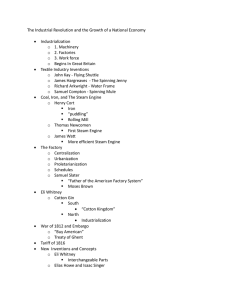

![Unit 1: Colonial America [Discovery to 1776]](http://s3.studylib.net/store/data/009619002_1-79f813c60fb75b8a63dd26feaf2bf5e1-300x300.png)
